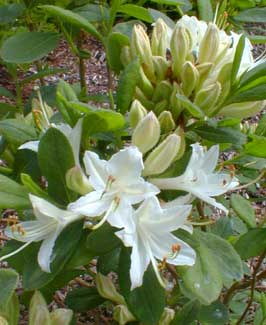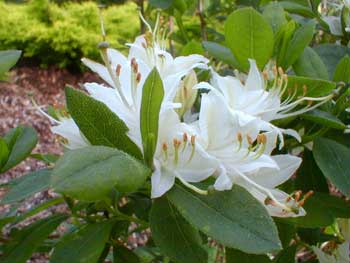
'Fragrant Star'
Deciduous Azalea
"I crept with curious feet
within imperial China's sacred bounds;
I saw the Palace of Pekin,
and all its fairy garden-grounds;
The green rice-fields, the tremulous rills,
the white azaleas on the hills."
-Ada Cambridge
(1844-1926)
(1844-1926)
'Fragrant Star' is a polyploid form of the deciduous azalea 'Snowbird' which was a natural hybrid between Rhododendron atlanticum native to the east coast of North America, & R. canescens found throughout the American south, as far west as Texas & north to Pennslvania.
Throughout its extensive range R. canescens has several common names. It is the Piedmont Azalea because Piedmont means "foot of mountain" where this species typically is found. It is the Hoary or Wooly Azalea after the glandular hairs in the tubes of the flowers, these hairs lacking in the similar-looking Pinxter Azalea (R. periclymenoides, formerly R. nudiflorum).
 R. canescens is additionally known as the the Florida Pinxster or Sweet Pinxster because it resembles R. periclymenoides both of which are usually pink, though white & yellow variants exist.
R. canescens is additionally known as the the Florida Pinxster or Sweet Pinxster because it resembles R. periclymenoides both of which are usually pink, though white & yellow variants exist.It's the Sweet Mountain Azalea, & it's the Wild or Bush Honeysuckle because its nectar attracts hummingbirds as reliably as do true honeysuckles; their sweet scent can be detected, honeysuckle-like, from a great distance; & when the truss's blooms are not yet fully opened they even look a bit like honeysuckle blossoms. It is occasionally called Swamp Azalea because it tolerates more wetness than the majority of azaleas.
Its other parent R. atlanticum is less widespread so has fewer common names. It is the Coastal Azalea or Atlantic Azalea because it grows all along the coastal plains of eastern North America from Delaware to Georgia. It is the Coastal Dwarf because it is very slow growing & comparatively short as the native azaleas go.
These two native azaleas overlap in their native range & hybridize with considerable ease, so intermediate forms exist in nature.
'Fragrant Star' was developed by Briggs Nursery here on Puget Sound, & Briggs obtained the original tissue cultures from the very first specimen at the Biltmore Estates of Ashville, North Carolina, famed for its extensive native azalea gardens.
Chauncey D. Beadle began work at Biltmore Estates in 1890, & spent sixty years of his long life insuring a lasting legacy. A Cornell-educated horticulturalist, Chauncey together with a couple of fellow azalea enthusiasts, spent many years exploring the hills of North Carolina & Kentucky in search of unusual variations of native azaleas, keeping detailed fieldnotes of their discoveries.
In 1940, ten years before his death, Chauncey requested that "my children," meaning his azaleas, which by then numbered in the thousands, be moved to the fifteen-acre Biltmore Estates Glen, one of the several gardens for which he was the primary caretaker. The Glen is today known as the Biltmore Estate's Azalea Garden, & is visited annually by thousands of azalea lovers.
The blossoms & blue-green leaves of 'Fragrant Star' are slightly larger than the average for 'Snowbird,' & the white flowers are intensely fragrant. I planted the specimen shown here in a friend's gardeeeeen, very close to a path, in rich soil behind a little rocky ledge-garden of lewisias. Putting it by the path felt essential to completely appreciate its redolence, though in fact it wafts its perfume some distance.
It has an upright growth habit with a ten-year size of four by four feet, so growth is rather slow. It can be grown in full sun or partial sun or partial shade, but won't bloom well in deep shade.